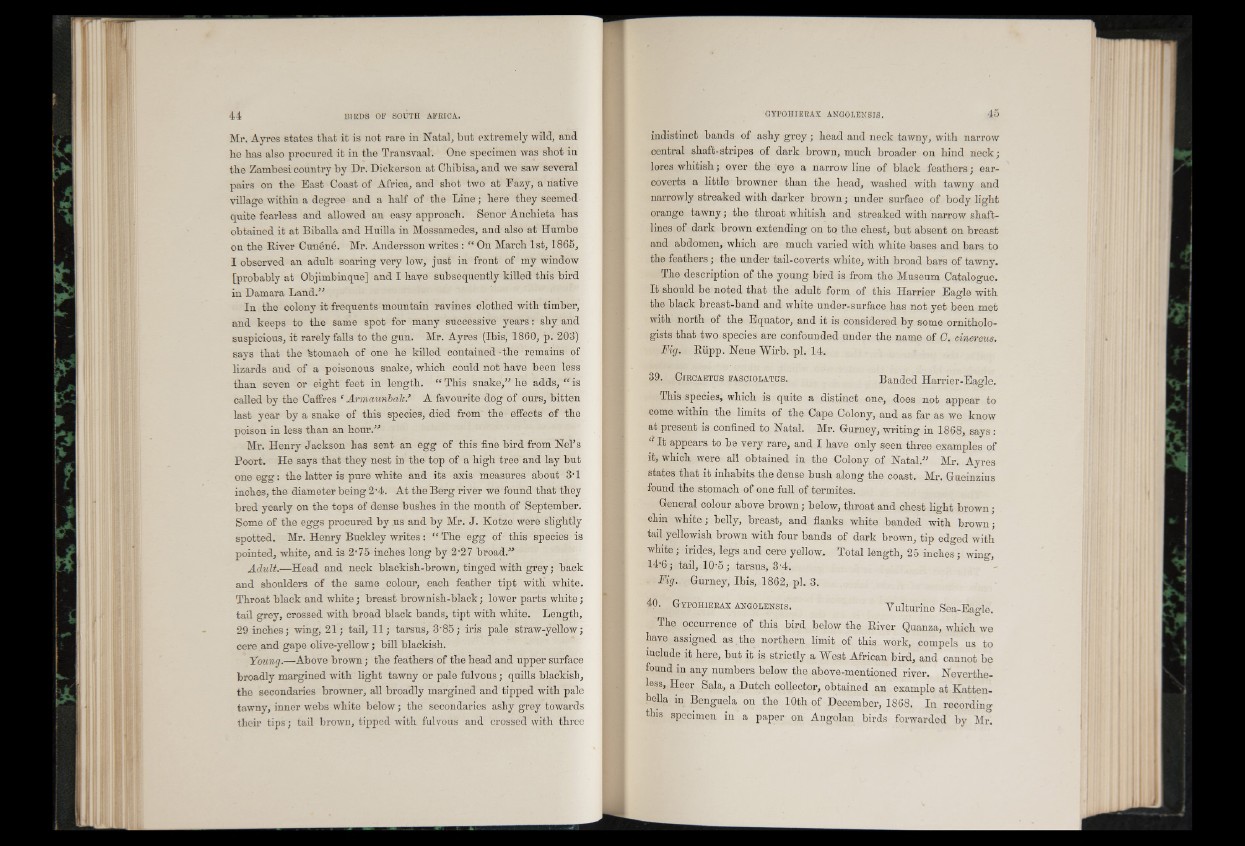
Mr. Ayres states that it is not rare in Natal, but extremely wild, and
he has also procured it in the Transvaal. One specimen was shot in
the Zambesi country by Dr. Dickerson at Chibisa, and we saw several
pairs on the East Coast of Africa, and shot two at Fazy, a native
village within a degree and a half of the Line; here they seemed
quite fearless and allowed an easy approach. Senor Anchieta has
obtained it at Biballa and Huilla in Mossamedes, and also at Humbe
on the River Cunene. Mr. Andersson writes: “ On March 1st, 1865,
I observed an adult soaring very low, just in front of my window
[probably at Objimbinque] and I have subsequently killed this bird
in Damara Land.”
In the colony it frequents mountain ravines clothed with timber,
and keeps to the same spot for many successive years: shy and
suspicious, it rarely falls to the gun. Mr. Ayres (Ibis, 1860, p. 203)
says that the btomaeh of one he killed contained - the remains of
lizards and of a poisonous snake, which could not have been less
than seven or eight feet in length. “ This snake,” he adds, “ is
called by the Caffres ‘ ArmaunbaJc.’ A favourite dog of ours, bitten
last year by a snake of this species, died from the effects of the
poison in less than an hour.”
Mr. Henry Jackson has sent an egg of this fine bird from Nel’s
Poort. He says that they nest in the top of a high tree and lay but
one egg: the latter is pure white and its axis measures about 3T
inches, the diameter being 2'4. At the Berg river we found that they
bred yearly on the tops of dense bushes in the month of September.
Some of the eggs procured by ,us and by Mr. J. Kotze were slightly
spotted. Mr. Henry Buckley writes: “ The egg of this species is
pointed, white, and is 2-75 inches long by 2'27 broad.”
Adult.—Head and neck blackish-brown, tinged with grey; back
and shoulders of the same colour, each feather tipt with white.
Throat black and white; breast brownish-black; lower parts white;
tail grey, crossed with broad black bands, tipt with white. Length,
29 inches; wing, 21; tail, 11; tarsus, 3'85; iris pale straw-yellow;
cere and gape olive-yellow; bill blackish.
Young.—Above brown; the feathers of the head and upper surface
broadly margined with light tawny or pale fulvous; quills blackish,
the secondaries browner, all broadly margined and tipped with pale
tawny, inner webs white below; the secondaries ashy grey towards
their tips; tail brown, tipped with fulvous and crossed with three
indistinct bands of ashy grey; head and neck tawny, with narrow
central shaft-stripes of dark brown, much broader on hind neck;
lores whitish; over the eye a narrow line of black feathers; ear-
coverts a little browner than the head, washed with tawny and
narrowly streaked with darker brown; under surface of body light
orange tawny; the throat whitish and streaked with narrow shaft-
lines of dark brown extending on tq the chest, but absent on breast
and abdomen, which are much varied with white bases and bars to
the feathers; the under tail-coverts white, with broad bars of tawny.
The description of the young bird is from the Museum Catalogue.
It should be noted that the adult form of this Harrier Eagle with
the black breast-band and white nnder-surface has not yet been met
with north of the Equator, and it is considered by some ornithologists
that two species are confounded under the name of G. cinereus.
Fig. Riipp. Neue Wirb. pi. 14.
3 9 . C ircaetus fasciolatus. Banded Harrier-Eagle.
This species, which is quite a distinct one, does not appear to
come within the limits of the Cape Colony, and as far as we know
at present is confined to Natal. Mr. Gurney, writing in 1868, says :
It appears to be very rare, and I have only seen three examples of
it, which were all obtained in the Colony of Natal.” Mr. Ayres
states that it inhabits the dense bush along the coast. Mr. Gueinzius
found the stomach of one full of termites.
General colour above brown; below, throat and chest light brown;
chin white; belly, breast, and flanks white banded with brown;
tail yellowish brown with four bands of dark brown, tip edged with
white ; irides, legs and cere yellow. Total length, 25 inches; wing,
14'6; tail, 10'5; tarsus, 3-4.
Fig. Gurney, Ibis, 1862, pi. 3 .
40. G y po h ie ea x ANGOLENSIS. Vulturine Sea-Eagle.
The occurrence of this bird below the River Quanza, which we
have assigned a s . the northern limit of this work, compels us to
include it here, but it is strictly a West African bird, and cannot be
found in any numbers below the above-mentioned river. Nevertheless,
Heer Sala, a Dutch collector, obtained an example at Katten-
bella in Benguela on the 10th of December, 1868. In recording
this specimen in a paper on Angolan birds forwarded by Mr.